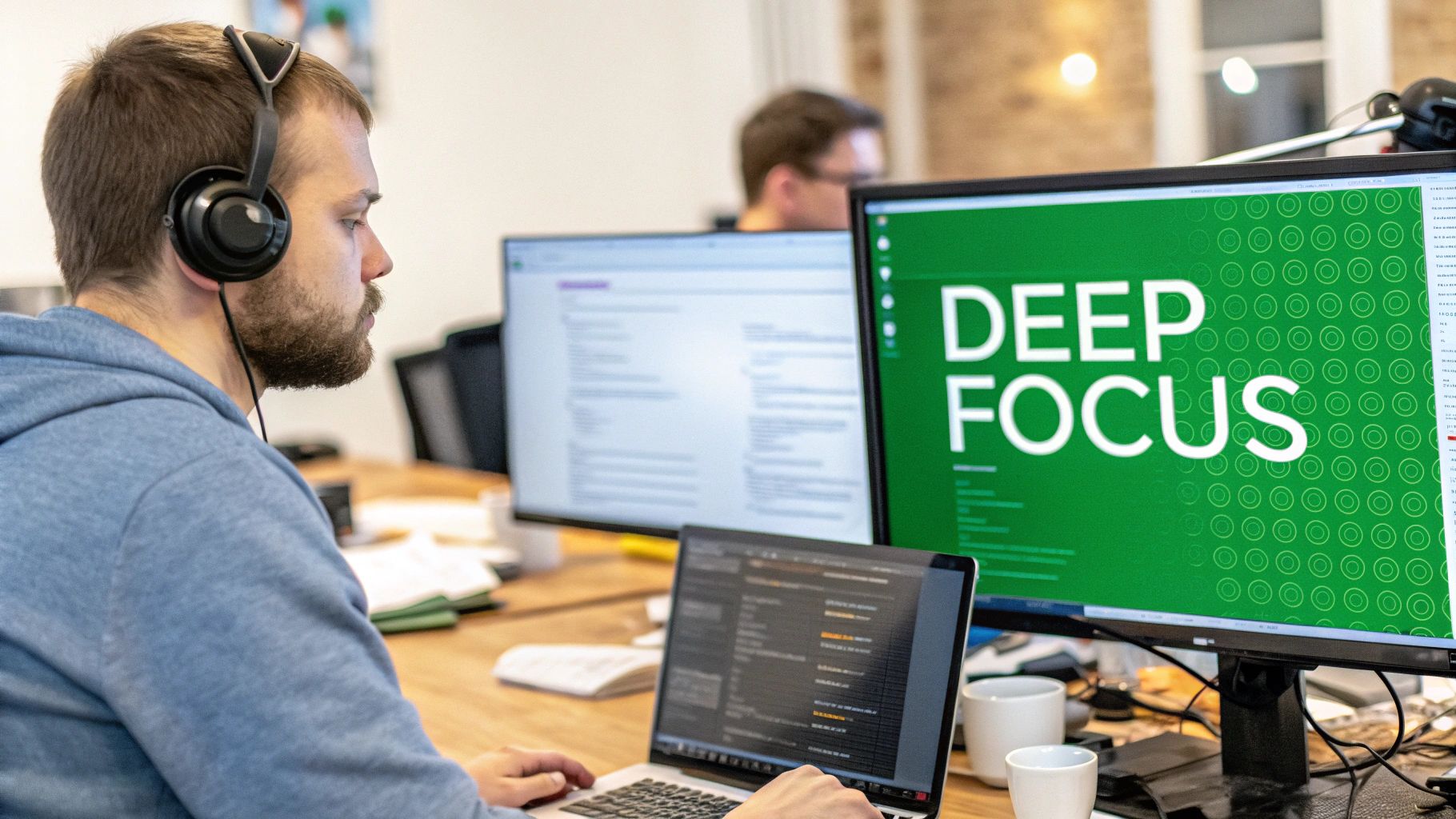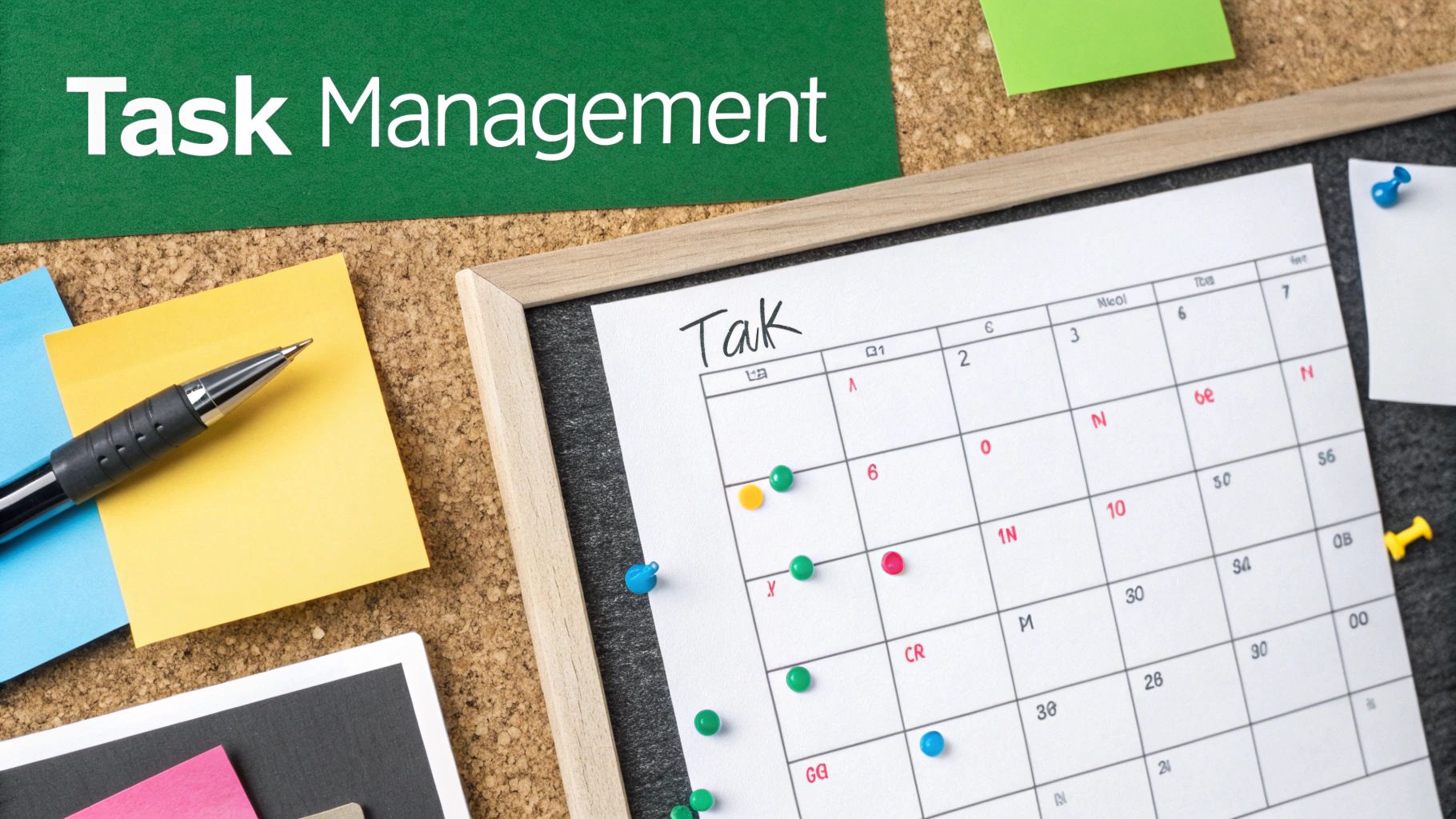Transform your development team's efficiency with proven strategies that drive measurable results. Learn from successful engineering leaders and discover practical approaches to boosting developer productivity.

Software development teams face mounting pressure to deliver results quickly. However, many are hitting significant roadblocks that slow down their work and impact their effectiveness. This points to a growing developer productivity crisis that affects companies both large and small.
The problem goes beyond individual work habits. One major challenge is context switching - when developers must repeatedly shift their attention between different tasks and requests. Picture a developer deep in solving a complex problem, only to be pulled into an urgent meeting. Getting back into that focused state takes considerable time and mental energy.
Current productivity tracking often misses the mark by focusing on surface-level metrics like lines of code written instead of real value delivered. This can create the wrong incentives, where quantity gets prioritized over quality. Teams might produce more code but fail to efficiently solve the core business problems they face. Common issues like slow approval processes and disconnected tools create frustrating bottlenecks that drain both time and motivation.
The numbers paint a clear picture of this crisis. According to a recent Cortex study, 90% of teams consider improving developer productivity their top priority. For teams that rated this as critically important (9-10 out of 10), 55% reported losing 5-15 hours per developer each week on unproductive work. The biggest time drains? 26% cited gathering project context and waiting for approvals. You can find the complete findings here: Learn more about the 2024 State of Developer Productivity. These lost hours directly impact project timelines, budgets, and the ability to innovate. To address these challenges, organizations need to move beyond outdated productivity metrics and find better ways to help developers do their best work.

Raw numbers like lines of code and commit counts can be misleading. These vanity metrics often fail to capture real impact and can actually harm productivity. To make meaningful improvements, we need to focus on outcomes rather than just activity levels.
Getting productivity measurement right is essential for any development team. While basic metrics like code volume don’t tell the full story, frameworks like DORA and SPACE provide much better insights. The DORA metrics examine key factors like how often teams deploy code and how quickly they recover from issues. For example, tracking lead time for changes shows how fast new code makes it to production - a vital indicator of team efficiency. Learn more about effective metrics in this helpful guide: Discover more insights about developer productivity metrics.
The DORA framework helps teams assess and improve their software delivery with four key measurements:
While DORA focuses on hard numbers, SPACE takes a broader view by including human factors:

Once you have solid productivity metrics in place, it’s time to bring AI tools into your development process. The key is being strategic about which tools you use and how you implement them. Let’s look at how to do this effectively.
Different AI tools shine in different areas - some are great at writing code, while others excel at documentation or performance optimization. For example, DocuWriter.ai can automatically generate code and API documentation, freeing up developers to focus on building features instead of writing docs. Think about your team’s specific needs when choosing tools.
A recent study by Slalom showed impressive results when a health insurance company tested AI coding tools. The numbers tell the story:
Speed is great, but quality code matters most. AI tools can help here too by automating code reviews, catching potential bugs early, and making sure everyone follows coding standards. This helps teams catch issues sooner rather than later when they’re more expensive to fix.
The only way to know if your AI tools are helping is to measure their impact. Keep an eye on:

Making development workflows more efficient is essential for better productivity. Teams need to identify and fix roadblocks while maintaining strong collaboration and code standards. Here’s how successful development teams make it happen.
Frequent task switching takes a heavy toll on developer focus and output. Picture a developer deep in solving a complex coding problem, then getting pulled into an urgent meeting. Research shows it can take 15-30 minutes to regain full concentration after an interruption. Setting up dedicated blocks of uninterrupted work time helps developers maintain focus and complete tasks faster. It’s like letting a chef cook without constant interruptions - they can work more efficiently and make fewer mistakes.
While code reviews are vital for quality, they shouldn’t become bottlenecks. Reviews that drag on with unclear feedback waste everyone’s time. The solution? Clear review guidelines, automated code checks, and reasonable time limits. Many teams aim to complete reviews within 24 hours to keep projects moving. Quick, constructive feedback helps maintain momentum and prevents code from getting stuck.
Smart automation frees up developers to focus on challenging, creative work. Automating repetitive tasks like testing, deployment, and documentation reduces manual effort and human error. For example, tools like DocuWriter.ai can handle code and API documentation automatically. This gives developers more time for complex problem-solving and innovation.
Individual productivity matters, but team coordination is just as important. The key is finding the right mix of focused work time and effective collaboration. Regular check-ins, shared project tools like Slack or Microsoft Teams, and open communication help teams work better together. When teams balance solo focus time with group problem-solving, they can tackle bigger challenges and share knowledge more effectively. This creates a positive cycle where individual and team productivity reinforce each other.
Building an environment where developers can excel takes thoughtful planning and sustained effort. Going beyond just tools and processes, it’s about creating conditions where teams can do their best work while maintaining wellbeing. The key elements include meaningful communication, work-life harmony, and understanding what development teams need to perform effectively.
Focus time is essential for developer success. Like a surgeon needs uninterrupted concentration during an operation, developers require dedicated blocks of time to solve complex problems. When developers constantly switch between tasks, both quality and efficiency suffer. Many teams now block off specific periods as “quiet hours” or designate certain days as meeting-free to enable deep work.
While some meetings are necessary, too many can fragment the workday and disrupt productive flow. Every meeting should have clear goals and run efficiently. Consider using project management tools or shared documents for updates that don’t require real-time discussion. This allows developers to engage with information when it fits their workflow, helping maintain their concentration.
Long-term productivity depends on maintaining a healthy work-life balance. Regular overtime and constant pressure lead to burnout, which hurts code quality and team morale. Key elements of sustainable practice include:
Strong individual focus must be balanced with effective teamwork. The most successful teams find ways to support both deep individual work and collaborative problem-solving. This can be achieved through:
This section outlines practical steps for enhancing developer productivity. It covers how to pinpoint and solve key issues, handle common roadblocks, and track improvement over time. Learn from successful teams about integrating feedback while keeping progress steady.
Begin by finding the most disruptive productivity issues in your workflow. Are meetings eating up coding time? Do code reviews create unnecessary delays? Focus on these high-impact problems first to get quick results and prove the worth of your efforts. This focused strategy helps tackle urgent needs while building support for future changes.
For instance, if your team struggles with frequent interruptions, setting up dedicated focus blocks could be your first step. If slow approval processes hold up releases, fixing that bottleneck should be a priority. Solving these core issues helps teams see real improvements quickly.
Make changes step by step to keep work flowing smoothly. Start with a small test group for new tools or methods, collect their input, and adjust before rolling out widely. This careful approach lets teams improve based on real feedback.
Get developers actively involved in planning changes. Their hands-on experience helps spot potential problems and ensures new processes actually work. When developers help shape solutions, they’re more likely to support and use them.
Change often brings obstacles. Teams might resist new methods, face technical issues, or hit unexpected snags. Plan for these hurdles and develop ways to address them. Strong leadership backing, clear updates, and emphasis on practical benefits help smooth the transition. Consider offering hands-on training for new tools or addressing specific workflow concerns.
You might be interested in: How to master essential software development best practices for further insights.
Keeping focus on improvements during company changes takes effort. Set clear goals, monitor progress, and celebrate wins to keep teams motivated. This helps ensure productivity stays a priority even when other big changes are happening.
Track key metrics like deployment frequency and lead time for changes to measure your impact. Share these findings with both teams and leaders to show concrete progress. This data helps justify continued investment in productivity tools and highlights which approaches work best. Regular measurement allows teams to fine-tune their methods for better results.
By applying these practical steps, you can turn insights into real improvements and build a more efficient, productive development environment.
Ready to unlock your team’s full potential? Try DocuWriter.ai today and experience the power of AI-driven documentation. Get started with DocuWriter.ai